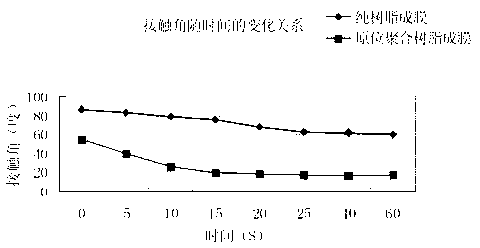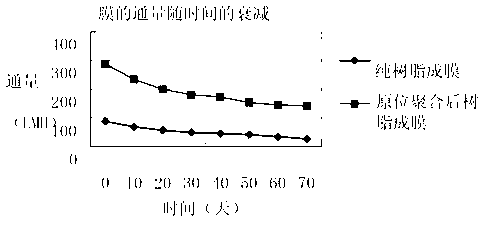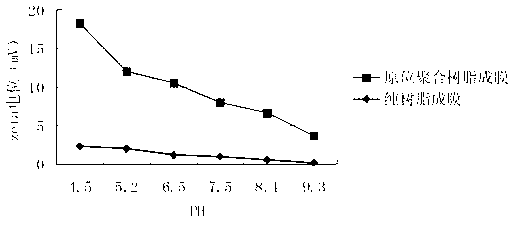Method for preparing hydrophilic electrical charge separation film by using one-step method as well as product and application thereof
A separation membrane and hydrophilic technology, applied in the field of microfiltration membrane, can solve the problem of lack of inorganic salt interception performance, and achieve the effect of enhancing anti-pollution performance, improving hydrophilicity, and saving complicated steps
- Summary
- Abstract
- Description
- Claims
- Application Information
AI Technical Summary
Problems solved by technology
Method used
Image
Examples
Embodiment 1
[0046] Example 1: Preparation of hydrophilic charged separation membrane
[0047] In parts by weight, 15 parts of polyvinylidene fluoride, 70 parts of N,N-dimethylpyrrolidone, 0.05 parts of benzoyl peroxide, 7.5 parts of dimethylaminoethyl methacrylate and 5 parts of porogen The polyethylene glycol was mixed, and the in-situ polymerization was carried out at a temperature of 60°C for 16 hours. Then let it stand at room temperature 25°C for 20 hours to defoam, then pour it into a gel bath, and let it stand at 20°C for 1 hour to obtain a phase-separated membrane; finally immerse it in a water bath and let it stand at 80°C for 1 hour. A hydrophilic positively charged separation membrane is obtained.
[0048] The thickness of the hydrophilic charged separation membrane is 0.5mm and the water flux is 2500L / m 2 .h, the average pore diameter is 0.01 microns, and the tensile strength is 1.2MPa.
Embodiment 2
[0049] Example 2: Preparation of hydrophilic charged separation membrane
[0050] In parts by weight, take 18 parts of polytetrafluoroethylene, 60 parts of N-methylpyrrolidone, 0.07 parts of azobisisoheptonitrile, 7 parts of acryloxyethyl trimethylammonium chloride and 4 parts of porogen Mix with Tween 80 and perform in-situ polymerization at a temperature of 99°C for 2 hours. Then let it stand at 20°C for 36 hours to defoam, then pour it into a gel bath, and let it stand at 80°C for 0.5 hours to obtain a phase-separated membrane; finally, pour it into a water bath and let it stand at 80°C for 1 hour to get Hydrophilic positively charged separation membrane.
[0051] The thickness of the hydrophilic charged separation membrane is 0.5mm and the water flux is 2800L / m 2 .h, the average pore diameter is 0.01 microns, and the tensile strength is 1.6MPa.
Embodiment 3
[0052] Example 3: Preparation of hydrophilic charged separation membrane
[0053] Carry out the same method as Example 2, except that the film-making resin is 7 parts polyethylene, 90 parts N-methylpyrrolidone, 0.09 peroxycarbonate, 1 part dimethyldiallylammonium chloride and 1 part Tween 80 , Get a hydrophilic positively charged separation membrane.
[0054] The thickness of the hydrophilic charged separation membrane is 0.5 mm and the water flux is 2600L / m 2 .h, the average pore diameter is 0.01 microns, and the tensile strength is 1.5MPa.
PUM
| Property | Measurement | Unit |
|---|---|---|
| Thickness | aaaaa | aaaaa |
| Water flux | aaaaa | aaaaa |
| Average pore size | aaaaa | aaaaa |
Abstract
Description
Claims
Application Information
 Login to View More
Login to View More - R&D
- Intellectual Property
- Life Sciences
- Materials
- Tech Scout
- Unparalleled Data Quality
- Higher Quality Content
- 60% Fewer Hallucinations
Browse by: Latest US Patents, China's latest patents, Technical Efficacy Thesaurus, Application Domain, Technology Topic, Popular Technical Reports.
© 2025 PatSnap. All rights reserved.Legal|Privacy policy|Modern Slavery Act Transparency Statement|Sitemap|About US| Contact US: help@patsnap.com



